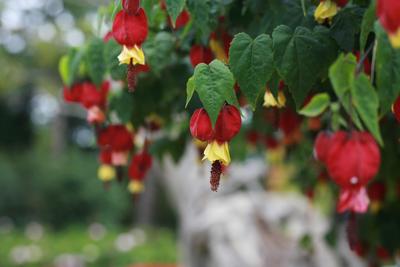I'm trying to root some cuttings from an abutilon, aka flowering maple. I cut 3-inch pieces, stripped most of the leaves and wrapped the cut ends in a damp paper towel and put them in a sealable plastic bag in a window, for three days now. When do I apply rooting hormone and place in potting soil? Also, my abutilon is about 4 feet tall and blooming in a pot on the sunny front porch. Should I cut it back to be bushier? When? — Cheryl
When taking cuttings, we generally only wrap the ends with damp paper towels and store them in plastic bags if we will delayed in planting them (such as when a friend gives you cuttings and you can't stick them until you get home). Otherwise, we stick the cuttings as soon as we take and prepare them. So, it's high time you took action. To do that, prepare pots of moist potting mix. You may root more than one cutting in a pot. Use your finger to make a hole for each of the cuttings. Dip the end of a cutting in rooting hormone, stick it in the hole and firm the potting mix around it. Put in a bright window or shady spot outside (while it is warm, bring inside when the weather gets chilly) for rooting.
My three lemon trees have borne a ton of fruit but really look raggedy. They are in desperate need of pruning, but I don’t know how. Any info …
You can cut back the original abutilon bush anytime you like. It's better to cut it back a moderate amount as needed to keep it bushy and an appropriate size than to let it get well overgrown and then have to cut it back a lot. But it will tolerate however much pruning you feel is needed.
We have a Knock Out rose. I would like to know when and how much it should be pruned back. It has gotten rather large. — Jerry
This is a timely question, as now is a good time to prune everblooming roses. We generally prune any time from late January through mid-February. This gets everblooming roses ready for their spring/early summer blooming season. This winter has been quite mild and many rose bushes are blooming now. Prune anyway. The timing is important to have the roses come back into bloom in April and May when the weather is mild. Use sharp bypass pruners, and be sure to wear leather gloves to protect your hands from the sharp thorns (gloves that reach your elbows are perfect for pruning roses).
Landscape roses, like Knock Out and all of its variations, are very easy to prune. There really is no set method or technique — it depends on what you want. Although touted to grow 3 to 4 feet tall and wide, if you have had yours for a few years, you know they can easily grow quite a bit larger. Regular pruning can keep the bush smaller if that is desirable.
If size control is the main issue, you can cut the bush back by as much as two-thirds its current height for maximum height control. However, do not cut it back lower than 18 inches from the ground. If size it not so much of an issue, pruning still helps rejuvenate the bush and encourage a more pleasing shape and abundant flowers. In this case, cut the bush back by about one-third to one-half. If there are and dead canes or branches, be sure to prune them out.
This basic information can also be generally applied to all landscape roses, shrub roses, polyantha roses and everblooming old garden roses. Naturally smaller-growing roses, such as Drift roses, generally don’t need as much pruning as more vigorous types. Hybrid tea, grandiflora and floribunda roses are cut back hard at this time, generally back to about 18 to 24 inches from the ground. Again, if your bush is in bud or flower, don’t let this stop you. Put buds and flowers in a vase, and they won’t go to waste.
The leaves of my split-leaf philodendrons have been damaged and are looking unattractive. Is it OK to cut off the leaves now? I would also lik…






